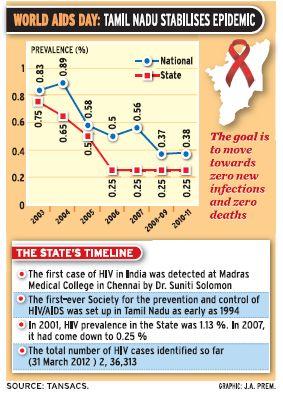 It has managed to retain stabilisation of its HIV/AIDS epidemic, holding on to prevalence rate of 0.25 %
It has managed to retain stabilisation of its HIV/AIDS epidemic, holding on to prevalence rate of 0.25 %
With the UNAIDS report putting India among the nations with a 50 per cent or over drop in HIV incidence rate (new infections), this is clearly good news for the country. Down south, Tamil Nadu, once considered a high-prevalence State, also has good news.
The State has managed to retain stabilisation of its HIV/AIDS epidemic, holding on to its prevalence rate of 0.25 per cent since 2007. Initial estimates at the State level indicate that there actually may be a drop in the rate (0.11 per cent), though next year’s sentinel surveillance will have to conclusively establish this trend.
“Our stress, as with the WHO, is to reach the magic figure of zero: zero infections and zero deaths,” says Kumar Jayant, Project Director, Tamil Nadu State AIDS Control Cell. “For this, while we continue our awareness drives and IEC activities, we also need to be able to keep track of every single infected person, and ensure that they get the drugs.”
Keeping track of every single person is now the challenge. In a State where a large section of the population accesses private health care, the reasoning is that a good number of people are testing themselves in the private sector. Tagging each and every person is the next step to take. Mr. Jayant says efforts have been initiated to involve the private sector in the Integrated Counselling and Testing Centres.
Already, about 76 private hospitals have been roped in to collaborate on running ICTCs — this information is available with TANSACS. The target is to reach about 300 private hospitals, he adds, and collect data about positive cases from there too.
In terms of setting up anti-retroviral therapy centres, link ART centres, ICTCs to detect and counsel patients with new infections, strengthening the blood bank system, and expanding IEC activities in a major way have been some of the prominent activities that have led the State forward.
A significant contributor to the way the epidemic has gone has been the Prevention of Parent to Child transmission programme. Pregnant women who test positive are closely followed up and adequate interventions are made to ensure that their children are not born with the HIV infection too. Sources in TANSACS say that the programme is working very well, with the rate of transmission from mother to child nearly down to five per cent among positive mothers.
Suniti Solomon of YRG Care, who detected the first HIV case in the country, says, “Over the last 25 years, we have done a really great job, especially in Tamil Nadu.” Awareness has gone up for sure, she adds, and while the number of patients among traditional high risk groups has come down, other high risk groups are emerging. The moral of the story is that there can be no laxity in handling the epidemic.
“We need to continue our vigil,” Dr. Solomon says. Currently, cost-effective formulations are available to treat HIV at the initial stages, and with counselling to ensure that the patient adheres to the regimen, it is possible to suppress the virus to levels that are undetectable, and thus, break the transmission cycle.




